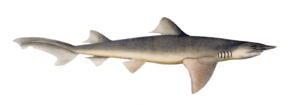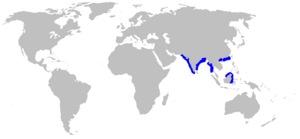Broadfin shark facts for kids
Quick facts for kids Broadfin shark |
|
|---|---|
 |
|
| Conservation status | |
| Scientific classification | |
| Genus: |
Lamiopsis
|
| Species: |
temminckii
|
 |
|
| Range of the broadfin shark | |
| Synonyms | |
|
Carcharhinus microphthalmus |
|
The broadfin shark (Lamiopsis temminckii) is a type of shark found in warm, tropical waters. It gets its name from its wide, flat pectoral fins, which are like the "arms" of the shark. This shark belongs to a group called requiem sharks, which are known for living in coastal areas. There are only two species in its genus, Lamiopsis; the other is the Borneo broadfin shark. The broadfin shark lives near the coast in the northern Indian Ocean. Sadly, it is currently listed as an endangered species.
Contents
What Does It Look Like?
Broadfin sharks show sexual dimorphism, which means males and females look a bit different. Female broadfin sharks are usually larger than males. They can grow up to about 175 cm (69 in) long. Males are typically smaller. You can also tell them apart by looking at their pelvic fins. Males have special calcified (hardened) parts called claspers at the end of their pelvic fins. These claspers help them reproduce.
Where Do Broadfin Sharks Live?
You can find broadfin sharks in parts of both the Indian Ocean and the Pacific Ocean. They have been seen near the coasts of countries like Pakistan, India, Indonesia, Burma, China, and Sarawak. These sharks prefer to stay in coastal waters. This means they live close to shore, usually over the continental shelf, which is the underwater land extending from a continent. Both male and female sharks are found throughout these areas.
Shark Life
How Broadfin Sharks Reproduce
Broadfin sharks are viviparous with a placenta. This means their young grow inside the mother, similar to how human babies develop. The mother provides food and oxygen to the embryos through an umbilical cord. When they are born, the young sharks have a small umbilical scar.
Female broadfin sharks usually have two to four embryos in each side of their uterus. A typical litter (group of babies born at once) has about eight young sharks. They are often born during the summer months, from March to September. Newborn broadfin sharks are about 41.8–65.0 cm (16.5–25.6 in) long. Because they don't have many babies at once, their population doesn't grow back quickly if numbers drop.
What Broadfin Sharks Eat
Broadfin sharks are predators in their coastal homes. They mainly eat crustaceans (like crabs and shrimp), teleosts (bony fish), and cephalopods (like squid and octopus). Studies of their stomach contents show that crustaceans are their favorite food. Even though they are top predators, broadfin sharks can get parasites. One type of tapeworm, called Sanguilevator yearsleyi, has been found in their blood.
Why Broadfin Sharks Need Our Help
The broadfin shark is an endangered species around the world. Scientists are still studying their numbers. It's possible that their population is even smaller than we think. This is because another similar shark, the Borneo broadfin shark, was recently identified. Sometimes, these two species might have been confused, making the broadfin shark's population seem healthier than it truly is. It might even be critically endangered.
Broadfin sharks have always had low population numbers. However, they used to be more common in places where a lot of fishing happens, like Indonesia and along the coast of India. One big reason for their decline is that they often get caught by accident in fishing nets. This is called "by-catch." Young sharks are especially at risk during late summer. This is when their birthing season happens to overlap with times when large fishing boats are not allowed to fish. This problem is common in the Arabian Sea and near India.
Since these sharks live in shallow, inshore areas where there are many fish, they can easily get caught in different types of fishing gear. This includes nets that sit on the bottom of the ocean, floating gill nets, and fishing lines. Not much has been done yet to solve this problem. Another reason for the broadfin shark's decline is the demand for shark fins, which are used in a dish called shark fin soup in some Asian countries. Sharks are also caught for their meat and their liver, which is used to make vitamin oil. However, new rules and policies are being developed to help protect these sharks.


